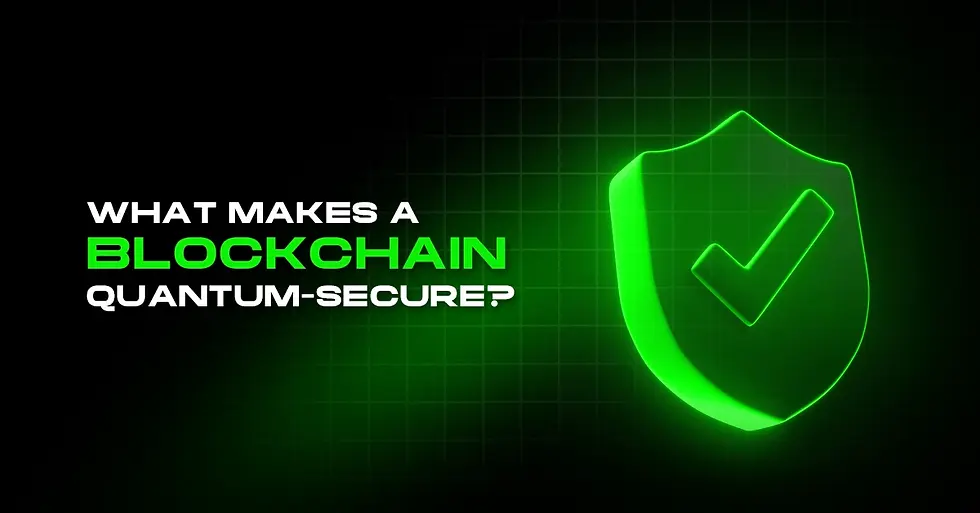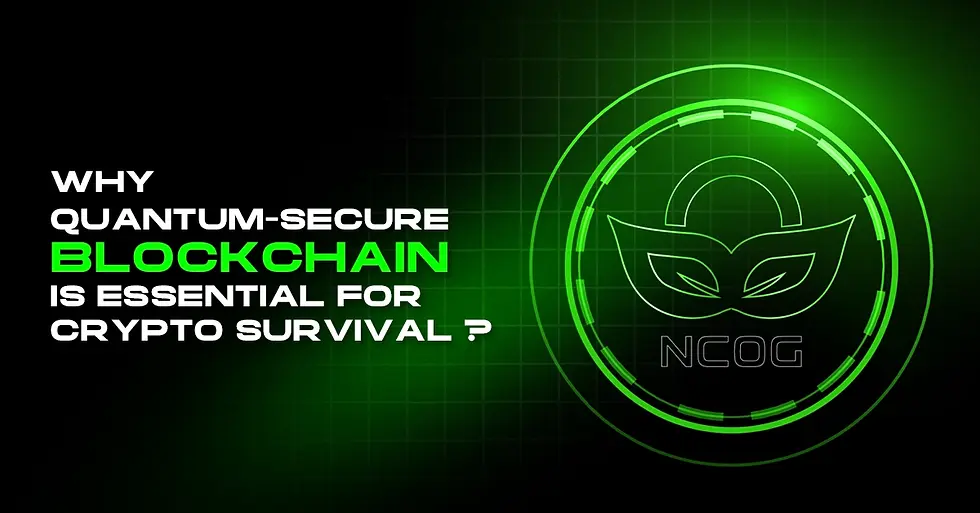Quantum-Secure Blockchain: Safeguarding the Future of Digital Transactions
- Nitin Kumar
- May 12
- 7 min read
In a time when quantum computers are no longer science fiction but a rapidly progressing reality, those antiquated systems of blockchain we once considered unbreachable are now under the unprecedented threat of attacks. So what's the answer? Quantum-Secure Blockchain. This new technology guarantees digital transactions will be safe, even from the potent processors of quantum computers.
This article goes in-depth into the nature, importance, and application of Quantum-Secure Blockchain so you know why it's not a luxury but a necessity of the digital age.
What Makes a Blockchain Quantum-Secure?

Blockchain networks implementing cryptographic methods to guard against quantum computing threats are referred to as Quantum-Secure Blockchain. Traditional blockchain networks utilize RSA (Rivest-Shamir-Adleman) and ECC (Elliptic Curve Cryptography) as their cryptographic mechanisms, but remain secure from classical computer attacks while remaining completely vulnerable to quantum-enabled Shor's Algorithm.
Shor's Algorithm demonstrates formidable capabilities in factorizing vast numbers as well as conducting discrete logarithm calculations, which undermine existing blockchain network protection mechanisms. The progressive development of quantum computers creates vulnerable cryptographic systems through broken encryption, preventing blockchain security and protected information from remaining secure.
Quantum-Secure Blockchain implements cryptography from the quantum-resistant category that delivers an entire blockchain defense against attacks from quantum computers. Quantum-Secure Blockchain implements cryptographic techniques that exhibit quantum resistance instead of conventional methods that quantum attacks can penetrate. Three quantum-resistant cryptographic methods include lattice-based cryptography, hash-based cryptography, and multivariate quadratic equations.
Lattice-based cryptography, for example, is based on the hardness of solving problems in high-dimensional spaces for the same reason that attacks conventional encryption, to which quantum computers don't seem to be able to do in an uncomplicated manner. Hash-based cryptography is based on the hash function being secure, and multivariate quadratic equations involve mathematical computations that are difficult for quantum computers to solve efficiently.
Through the implementation of these innovative methods, quantum Secure Blockchain makes sure that even when the quantum computers have reached their fullest development, they won't be able to breach the cryptographic security of the system.
The most important things about Quantum-Secure Blockchain are beyond the fact that it makes use of quantum-resistant algorithms. One of the key characteristics of Quantum-Secure Blockchain is that it employs bigger key sizes and more intricate mathematical bases than conventional blockchain systems. Quantum computers, which can perform enormous amounts of data in parallel, can take advantage of smaller key sizes and less complex mathematical issues much more efficiently than traditional computers.
Using bigger keys and more challenging mathematical hurdles, Quantum-Secure Blockchain keeps quantum computers at bay and ensures that neither can break into the encryption quite so readily. This additional layer of cryptographic strength makes Quantum-Secure Blockchain extremely resistant to attacks by quantum devices, protecting blockchain transactions and data in a fashion that ordinary cryptographical processes simply can't match.
Another crucial aspect of Quantum-Secure Blockchain is that it employs post-quantum cryptography and forward secrecy protocols. Forward secrecy assures that even if one's cryptographic key gets compromised in the future, historical communications and transactions are safe. This becomes particularly relevant in terms of quantum computers because quantum computers might decrypt archived data in the future.
Through applying post-quantum cryptography protocols, Quantum-Secure Blockchain can safeguard not only future data but even past data in a manner such that data placed on the blockchain is impenetrable even if today's data were intercepted and broken at some later date. With proactive security, it pre-protects blockchain networks from the increasing capabilities of quantum computing.
The vision of Quantum-Secure Blockchain is to anticipate and pre-empt the security threat represented by quantum computers before this can materialize into a genuine danger. By implementing quantum-resistant cryptography now, Quantum-Secure Blockchain creates an essential layer of protection that resists sensitive information against the unforeseen capacity of quantum computers.
The continuous development of quantum computing poses a constantly changing threat to cybersecurity, but Quantum-Secure Blockchain is designed with foresight and ingenuity to remain ahead of the curve. It is not only concerned with the present situation of cryptographic attacks, but also thinking ahead to developing blockchain systems for the future when quantum computers can potentially decrypt conventional encryption algorithms with ease.
By tackling such challenges head-on, Quantum-Secure Blockchain enables blockchain technology as a secure and reliable platform for digital transactions despite the advent of quantum computing. The more superior and powerful that quantum computers will become, the more critical will be Quantum-Secure Blockchain.
Not only is it theoretically imperative to transition to quantum-secure encryption methods, but an urgent imperative, as the future of blockchain hangs in the balance of quantum defense against attack. Quantum-Secure Blockchain, with its robust cryptographic processes and innovative thinking, provides the security needed to maintain the integrity of blockchain systems against impending quantum attacks.
Quantum Computing vs. Blockchain: The Security Solution

The connection between blockchain and quantum computing is that of danger and potential boon. The stupendous amount of computational power available with quantum computing would completely upset blockchain technology by breaking the very cryptography algorithms underpinning it. Blockchain relies strongly on asymmetric cryptography, which, as secure against traditional computers as it currently is, would be vulnerable to the sophisticated algorithms quantum computers would employ, specifically Shor's algorithm.
Such an algorithm can potentially factor large numbers quickly and accurately, undermining RSA and elliptic curve cryptography (ECC) that protects blockchain transactions today. But this weakens it yet. Quantum-Secure Blockchain is a promising resolution that can secure the guarantee of continued safety and reliability of blockchain against quantum threats.
Asymmetric cryptography stands as the core protection mechanism of blockchain security because public and private keys enable encryption and decryption functions. Traditional computers encounter great computational challenges when attempting to either factorize large numbers or determine discrete logarithms.
Quantum computers, which employ the principles of quantum mechanics, can accomplish this exponentially quicker, hence rendering current encryption outdated. This is where the real adversarial potential of blockchain and quantum computing comes into play. If quantum computers advance to a point, they can potentially undermine blockchain security by decrypting encrypted data and manipulating transactions, exposing blockchain networks to attack.
But Quantum-Secure Blockchain reverses this script. Instead of simply falling victim to the potential threat of quantum computing, Quantum-Secure Blockchain has been designed specifically to resist such future attacks. The cryptographic approach of Quantum-Secure Blockchain offers security by resisting all potential unauthorized access from quantum computers that might break standard encryption.
The secure quantum-resistant algorithms use mathematical challenges that quantum computers cannot easily resolve through three types of cryptography: lattice-based, hash-based signatures, and code-based. Through the incorporation of these new strategies, Quantum-Secure Blockchain allows blockchain systems to remain resolute, maintaining their fundamental purpose of offering secure, transparent, and decentralized transactions.
Transition to Quantum-Secure Blockchain is not an anticipatory measure, but it is unavoidable. Blockchain's application of asymmetric cryptography is its weak point in the event of quantum computing. Existing cryptographic infrastructures might be sufficient to provide sufficient security against attacks based on classical computation, but they are no match for the brute force processing capability of quantum computers.
Quantum-Secure Blockchain has never been more necessary, since quantum computers continue to move closer to being powerful enough to decrypt the methods used to safeguard digital transactions for decades. Therefore, Quantum-Secure Blockchain is not merely a future upgrade to be done optionally; it is the new standard that blockchain networks will have to adopt to survive in the post-quantum era.
The quantum computing threat to making blockchain susceptible exists, but now with the emergence of Quantum-Secure Blockchain, there is a simple answer. Using proper cryptographic techniques, blockchain networks will be able to survive even in the quantum era. Developing and using Quantum-Secure Blockchain is needed to make sure blockchain networks will withstand the brunt of heavy quantum computing attacks looming on the horizon.
The ongoing expansion and deployment of blockchain across sectors like finance, healthcare, and government necessitate the level of vision that Quantum-Secure Blockchain provides. Besides averting quantum attacks from undermining data integrity, it also guarantees the long-term sustainability of blockchain technology in securing transactions and establishing trust within industries.
The development path of quantum computing requires quantum-secure blockchain to secure blockchain systems from threats generated by the emerging computational strength. The Quantum-Secure Blockchain solution shows how to create blockchain networks with modern quantum attacks prevention while maintaining complete security principles. With the advent of quantum-resistant algorithms, Quantum-Secure Blockchain guarantees that blockchain will continue to be the linchpin of secure digital transactions and is a primary solution to the problem of quantum computing.
Quantum-Secure Blockchain is not only a security measure for blockchain against quantum computing, but also charts the future of blockchain in itself. Global infrastructure growth of blockchain networks creates a stronger demand for Quantum-Secure Blockchain technologies.
The lack of Quantum-Secure Blockchain would make blockchain networks susceptible to quantum-based attacks, so that trust in decentralized systems would decrease. However, with Quantum-Secure Blockchain, blockchain can be designed to address the needs of a quantum-energy-rich world, such that its authenticity is guaranteed through the next century.
The emergence of quantum computing is a threat and a prospect to blockchain technology. Quantum computers are not only capable of deciphering the cryptographic methods used to protect blockchain transactions, but Quantum-Secure Blockchain presents a pre-emptive strike in proposing quantum-resistant encryption techniques. Asymmetric cryptography for blockchain is a vulnerability that needs to be eliminated, and blockchain security's future rests on Quantum-Secure Blockchain.
The normal practice of the future will be Quantum-Secure Blockchain because it protects blockchain from quantum attacks while ensuring its operation during such potential threats. Through the implementation of Quantum-Secure Blockchain, organizations can protect blockchain technology as an essential secure digital transaction solution even after quantum computers become operational.
Why Quantum-Secure Blockchain is Essential for Crypto Survival

Cryptocurrency remains in an important stage of development because its global market value exceeds $2 trillion. The market has grown to an enormous size and adoption, but it also has enormous problems to solve. Of particular concern is the quantum threat. While traditional blockchains such as Bitcoin and Ethereum are secure against vanilla computers, they are not secure against quantum attacks by design.
As quantum computers are developing, they may be able to break through the cryptographic technologies that secure blockchains today. Unless something is done in advance, the prospects of cryptocurrencies become doubtful, and Quantum-Secure Blockchain...




we ensure your Chardham Yatra is not just a trip but a lifetime experience. With our expert guidance, personalized itineraries, and top-notch services
When it comes to vacation property investments, two of the most common terms that come up are fractional ownership